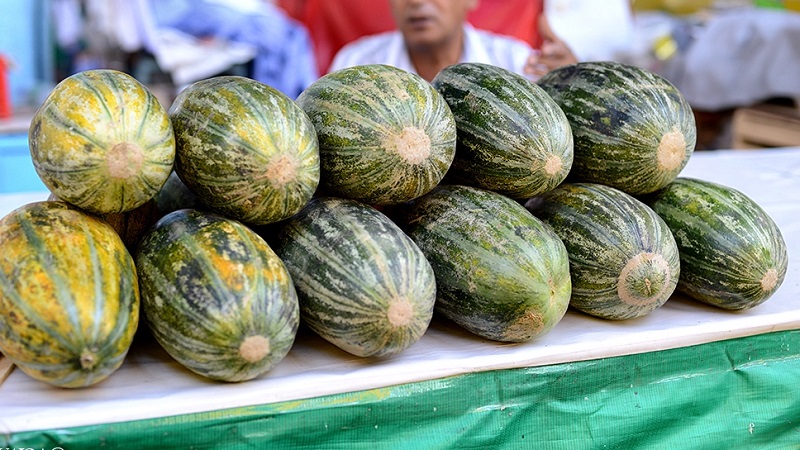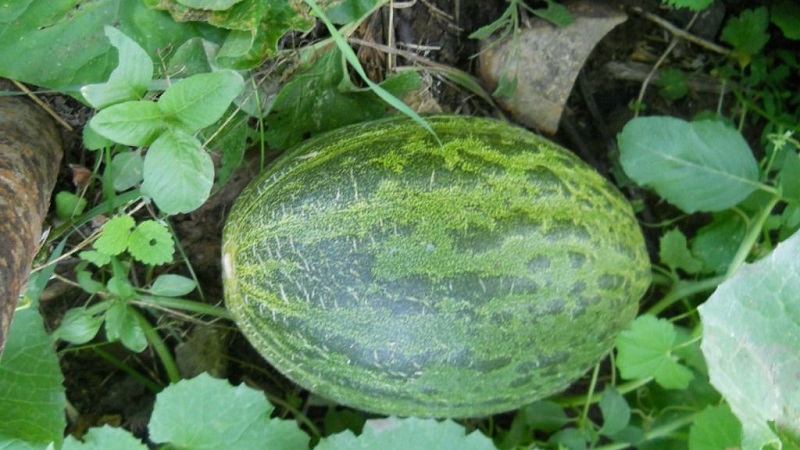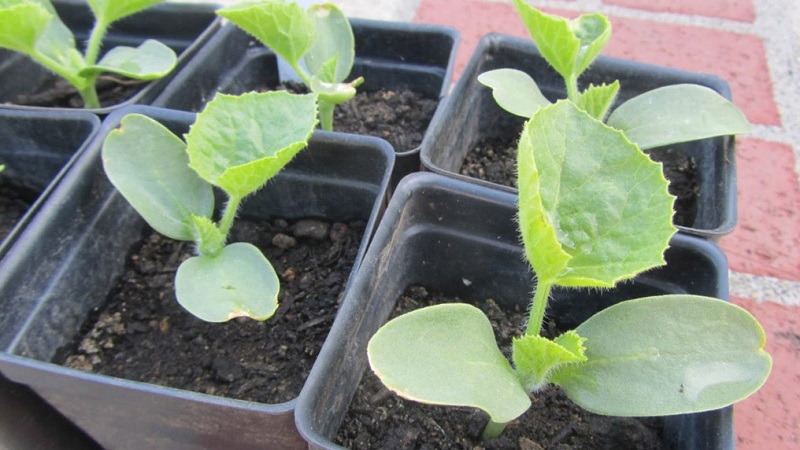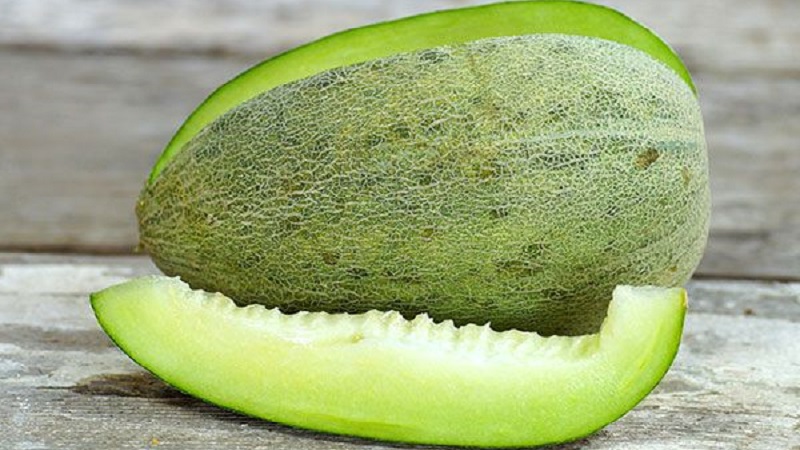Fragrant and tasty Khasanka melon: how to choose and grow on your site
Khasanka is a unique melon variety, there is not much information about it. Few people know about it and rarely cultivate it. But those who have already tried and grown it did not remain indifferent. About what its features are, what advantages it has and how to grow it correctly - in our article.
The content of the article
Description of the Khasanka melon variety
The fruits of this variety are oblong in shape.... When ripe, Khasanka does not turn yellow and does not reach large sizes. Let's talk in more detail about its features, composition and characteristics.
The photo shows the Khasanka melon.

Distinctive features
For the variety characteristic greenish skin color with intermittent "watermelon" stripes.
This color often scares off buyers - it seems that the fruit is not ripe. But the melon just needs to be opened - inside it is yellow and juicy.
Composition, benefits, calories
100 g of melon contains:
- proteins - 0.6 g;
- fat - 0.3 g;
- carbohydrates - 7.4 g;
- dietary fiber - 0.9 g;
- water - 90 g.
Calorie content - 33 kcal.
Vitamins and minerals in Khasanka melon:
- vitamin A;
- B vitamins (B1, B2, B3, B5, B6, B9);
- vitamin C;
- vitamin E;
- iron;
- iodine;
- zinc;
- copper;
- manganese;
- fluorine;
- cobalt;
- phosphorus;
- sodium.
Melon juice is used to whiten skin, it does an excellent job with pigmentation problems and eliminate pimples.
In folk medicine, melon is indicated for tuberculosis, rheumatism and anemia.
Reference. The main benefit of melon is its ability to alkalize the body. Its pH is 6.0-6.7.
Specifications
Melon Khasanka belongs to melons, pumpkin family... Finicky in leaving. It grows in dry hot climates.
The bushes of this culture resemble a liana with a characteristic fluff on the stems.... Leaves are deep dark green, reminiscent of pumpkin. Fruits are oblong, striped, sometimes confused with watermelons from afar. Do not turn yellow when ripe.

The ripeness of Hasanka is checked by pressing on the peel: it should be moderately soft. That is, to bend under the fingers, but not flatten or burst, but return to its original position.
Melon pulp is light, dense and juicy... In terms of sweetness, it is not inferior to the popular Kolkhoz woman. Khasanka is one of those varieties that are called honey.
At home, in Turkmenistan, it grows up to 4-5 kg. In Russia - up to 1.5-2 kg. Cultivation is possible both in the southern regions and in the middle lane.
Resistant to transportation and storage... It tolerates them better than other Central Asian varieties.
How to choose fruits when buying
Most of us rely on smell when buying fruit... But with Hasanka everything is different. Melon will not reveal its flavor while it is whole. The amazing smell of this variety can be felt only by cutting the fruit.
But it is not recommended to buy Hasanka cut or in portions: unscrupulous sellers can cut off the rotten areas (and the residual effect of rotting on the pulp will remain after that), and sell you a low-quality product.
When choosing a melon, pay attention to the following:
- Skin surface: it should be flat, free from dents and scratches.
- The buyer should be alerted by the presence of even one small gray or black speck on the melon peel. This means that the fruit has begun to rot and that the affected area of the melon will definitely taste bitter.
- The pressure on the melon is not carried out over the entire surface, but selectively - you need to press on the "nose" of the melon.There should not be any dents after pressing - they mean that the fruit is overripe.

If it is hard near the melon "nose", buy Hasanka anyway and let it sit for 2-3 days at a temperature of + 18 ... + 20 ° C. In such conditions, it will certainly ripen.
Experts say that at the height of the season, a truly tasty Khasanka is also difficult to find because from the places where it grows (the countries of Central Asia), the fruits begin to be transported still green. Not every carrier adheres to storage standards, so the melons do not ripen on the way, but wither.
What to do in this case? Wait until September - during this period, ripe and delicious Khasanki of winter varieties are delivered from Central Asia, and melons are bought only at proven points. With a little patience, you are guaranteed a delicious tasting of aromatic melons with honey sweetness.
Other melon varieties:
How to grow a variety yourself
Khasanka is a variety that requires careful care and compliance with agrotechnical rules.
In Russia, the cultivation of this variety is possible. Culture thrives best in hot regions, since the plant is thermophilic and demanding on light and moisture levels. Khasanka is grown by seed and seedling methods.
Growing in stages and care
Steps in the seed method of growing melon:
- Selection and preparation of seed material. The seeds should be full, not shriveled or empty. Before planting in the ground, they are soaked in warm water for 3-8 hours.
- Preparing the beds. Melon needs a well-lit, low-wind place, loose, light soil rich in organic matter.
- Sowing. The optimal time is April 20-May 10, when the soil warms up to + 14… + 16 ° C. Sowing is completed on June 10. The first shoots appear in 7-10 days.
- On the 4-6th day after the emergence of shoots, you can see that the shoots develop slowly and "lazily". Do not let this bother you - during this period, the development of the root system of the melon is actively taking place, all the forces of the plant are thrown there. The growth of the bush is activated after the appearance of 6-8 leaves - this is the beginning of branching of the melon.
- Flowering begins with male flowers. They are laid in the axils of 2-3 or 4-5 shoot leaves. The appearance of female flowers occurs after the formation of 6-30 male flowers.
- Fruit formation. 1-5 fruits are formed on one bush. If there are many ovaries, the bush is eliminated from the extra ones.
- Completion of growth and maturation. Fruits complete their growth about 30 days after setting - during this period they intensively accumulate sugar. The melon fully ripens phase lasts a few more days, from 8 to 20.

Seedling stages:
- Sowing. It is better to plant the prepared seeds immediately in separate cups, preferably peat ones, since the melon painfully tolerates the transplant and so it will be more comfortable for it to take root in a permanent place. Deadline - early May.
- Shoots. Khasanka hatches 5-7 days after sowing, provided that the plant is kept at a stable temperature of + 20 ° C.
- Watered for the first time with warm, settled water after the formation of the first leaf.
- Pinching is carried out after the appearance of the third pair of sheets. The procedure is necessary to form a bush.
- Plants are transplanted into open ground in early June.
Further development of the plant is the same as that grown from seeds.
Important! The basic rules for caring for a melon: regular watering (at the root when the soil dries up), loosening the row spacings and feeding (2-3 times until the leaves close).
For feeding use:
- ammonium nitrate (immediately after mass shoots);
- organic solution in a ratio of 1:10 (budding phase);
- a solution of phosphorus-potassium fertilizers in a proportion of 20 and 50 g per bucket of water (three weeks after the previous feeding).
If the site was fertilized only with minerals for a long period, the soil becomes acidic. Before planting melons, they are limed.
Features of cultivation and possible difficulties
To obtain a full-fledged Khasanki harvest, it is important limit the development of the vegetative mass of the bush, that is, pinch the shoots.

The procedure is simple: Pinch the main lash and leave two side ones. It is important not to forget to do this so that the luxurious bushes do not turn out to be barren.
Despite the firmness of the rind, the melon does not always withstand high humidity and is subject to mechanical damage. The guarantee of protection against damage - care during collection and transportation, and from high levels of humidity - moderate watering and the presence of bedding. Even small melons are laid out on pieces of roofing material or other similar material so that they do not touch the ground.
Another way to avoid fruit rot is to pull the melons out of the bush. When Khasanka is planted on the ridge of the garden, the gardener, already at the sowing stage, makes life easier for himself and the plant. In the future, if necessary, roll out the melons for ripening in the sun, it will be easier to do this - an inclined bed will help.
Diseases and pests characteristic of the variety
Like other melons, Khasanka melon is susceptible to fungal diseases that develop with high soil moisture.
Common diseases:
- powdery mildew;
- fusarium;
- anthracnose;
- peronosporosis.
How to treat:
- "Fitosporin";
- Alirin-B;
- "Gamair";
- "Baktofit";
- "Planriz".
Pestswho love to feast on melon:
- aphid;
- scoop;
- spider mite;
- wireworm.
For pest control use bioinsecticides (against gnawers - "Bitoksibacillin", "Basamil", "Fitoverm", "Aktofit", against suckers - "Mycoafidin" and "Verticillin").

Harvesting and application of the crop
Melons of this variety are harvested as they ripen... Semi-ripe fruits are stored and ripened in a room with a comfortable temperature. It is best to store them hanging in nets or laid out on shelves.
Important! If the room is hot (temperatures above + 22 ° C), then the fruits will become soft and lose their taste.
The collection period in Russia depends on the region of cultivation, the quality and value of plant care. The melon ripens on average 45-75 days. Usually, the mass harvest begins in August.
Advantages and disadvantages of the variety
Despite the similar vitamin and mineral composition, each melon variety has its own characteristics.
Among the benefits of Khasanka melon is worth noting:
- sweet taste similar to pineapple;
- juiciness;
- high productivity;
- good transport tolerance.
Read also:
What is good about the Kassaba melon, how to choose and grow it
Disadvantages of the variety:
- fruits do not show aroma when uncut, which makes it difficult to select ripe melon;
- the variety is picky about growing conditions.
Conclusion
Khasanka is an amazing melon, the taste and aroma of which are hidden behind a strong skin. She is demanding in care, but the patient gardener will certainly delight a rich harvest. If you are in no hurry to grow it on your site, but want to taste it, remember the rules for choosing the fruit so as not to be disappointed in the purchase.